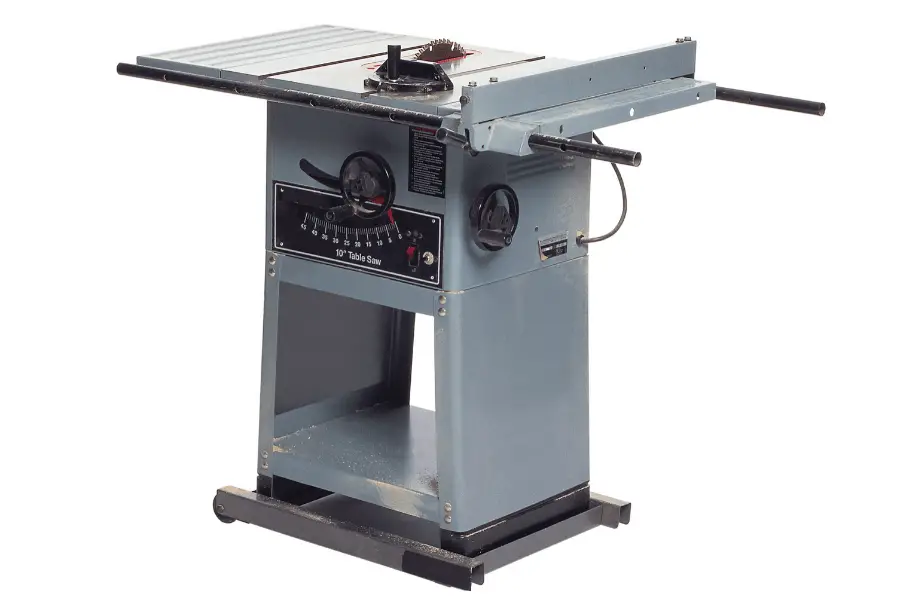
Here is a detailed description of all the parts of a table saw. The table saw is the most popular power tool in woodshops because of it’s versatility and efficiency in cutting wood. It is very important to understand this tool inside and out to grow your woodworking skills and confidence.
What Are The Parts Of A Table Saw? All of the parts include Table Saw Blade, Blade Guard, Auxiliary Table Inserts, Standard Table Insert, Miter Gauge, Rip Fence, Table Surface, Blade Angle Adjustment Crank, Blade Angle Scale, Blade Height Adjustment Crank, Lock Knob, On/Off Switch, Roller Stand, Mobile Base, Vacuum Attachment, Optional Rip Fence, Hold-down Device, Auxiliary Fence, Extension Table, Rip Fence Guide Bar and Fence Lock.
Read further down below for more details on each of these table saw parts.
What Are The Parts Of A Table Saw?
Large or small, the table saw is basically a motor and arbor assembly attached to a base cabinet or stand. The arbor may be mounted directly to the motor shaft, or connected to the motor by a belt and pulley. In general, better saws have more than one belt.
Precise blade adjustments are made by means of two crank-type handwheels underneath the saw table. One wheel controls the blade’s height above the saw table from 0 to 3 ½ inches on a 10-inch saw. The other wheel adjusts the angle of the blade from 90 degrees to 45 degrees.
The rip fence, which on most models slides along the front and rear guide bars to control rips cuts, can be locked anywhere along it’s track at the desired distance from the blade. Some fences feature measuring tapes attached to the front guide bar or even, in some cases, electronic readouts, although experienced woodworkers usually rely on a handheld measuring tape and a sample cut to check the width of a cut.
Shallow slots, milled into the saw table on each side of the blade, accept an adjustable miter gauge for guiding crosscuts. Quality saws have tables that are cast and then machined for flatness.
What Are The Parts Of A Table Saw?
- Table Saw Blade: Blade that cuts the workpiece.
- Blade Guard: Clear shield that protects operator from blade; bolted to splitter and anti-kickback device.
- Auxiliary Table Inserts: Keeps wood pieces from falling into table; wider slots for dado or molding heads.
- Standard Table Insert: Keeps wood pieces from falling into the table.
- Miter Gauge: Guides workpiece across table for crosscutting; wooden jig extension can be screwed to gauge to support wide pieces.
- Rip Fence: Guides workpiece across table for ripping.
- Table Surface: Table you slide the workpiece along as you cut.
- Blade Angle Adjustment Crank: Adjusts the angle of the blade.
- Blade Angle Scale
- Blade Height Adjustment Crank: Adjusts the height of the blade.
- Lock Knob: Holds crank at fixed setting; tightened firmly before saw is operated.
- On/Off Switch: Magnetic switch turns off saw if machine is unplugged.
- Roller Stand: Supports long workpieces during cutting operations.
- Mobile Base: Facilitates moving the saw aside in small shops; wheels can be locked in position.
- Vacuum Attachment: For dust collection system.
- Optional Rip Fence: Longer fence replaces standard fence when extension table is used.
- Hold-down device: Holds workpiece firmly against both table and rip fence for safe rip cuts.
- Auxiliary Fence: Board clamped or screwed to rip fence extends height of fence and protects it.
- Extension Table: Increases work surface to facilitate cutting large boards and panels.
- Rip Fence Guide Bar: Holds optional rip fence to extension table; features rule for measuring width of cut.
- Fence Lock: Holds rip fence in fixed position.
Subscribe to Rockler Woodworking and Hardware on Youtube
